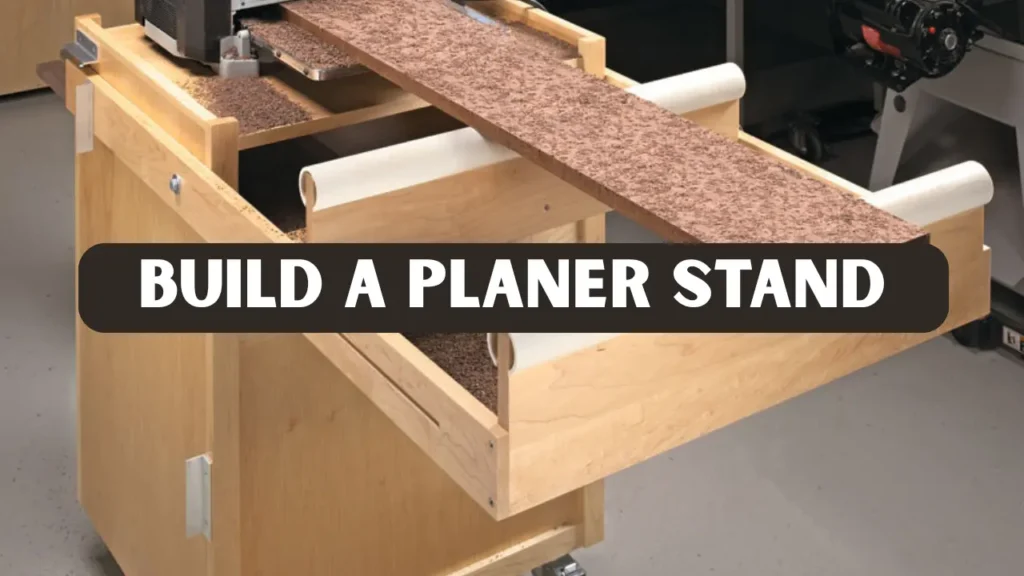A well-organized woodworking shop requires more than just skill. The right tools, proper setups, and efficient workflows make the difference between a successful project and a frustrating experience. One essential piece of equipment that is often overlooked is the planer stand, which provides stability and support for your planer. With the proper stand, you can work more safely, efficiently, and accurately, especially during longer woodworking sessions where precision matters most.
Beyond supporting your planer, a quality stand can help organize your workspace by providing additional storage or a dedicated platform for tools and materials. In workshops where space is limited or multiple tools are in use, having the right support solution improves workflow and reduces physical strain. This guide will cover all aspects of selecting, building, and using a stand effectively, giving you the knowledge to optimize your woodworking setup.
What Is a Planer Stand and Why You Need One
A planer stand is a sturdy platform designed to hold a thickness planer securely, providing stability during planing operations. Beyond stability, it enhances user comfort, improves workflow, and helps keep the workspace organized. A well-built stand reduces vibrations, allowing for more precise cuts while minimizing the risk of accidents. It also positions the planer at an ergonomic height, reducing strain on the back and shoulders during extended use.
Some stands are designed for mobility, featuring casters or wheels that make it easy to move the planer between workstations. Others include integrated storage, offering space for blades, push blocks, or scrap wood to keep the shop tidy. There are several types to suit different needs: DIY wooden stands for customization, rolling stands for portability, and commercial metal stands for heavy-duty, long-term use. Choosing the right stand depends on your workshop layout, workflow, and planning requirements.
How to Select the Ideal Stand for Your Planer
Selecting the ideal stand requires careful consideration of your planer model, workshop layout, and workflow needs. A stand that is too small or weak can compromise safety and efficiency, while an overly large one may take up unnecessary space. Evaluating the dimensions of your equipment and available workspace ensures a practical and functional setup that supports both safety and productivity.
Weight capacity and size are critical factors. The stand must be able to safely support your planer as well as the boards or materials you plan to work with. Measuring the width, length, and height of your planer is essential for a proper fit. Slightly overestimating dimensions can accommodate larger boards and potential future upgrades, ensuring the stand remains useful as your workshop needs evolve.
Choosing the right material for a workshop stand is essential for durability and performance. Wooden constructions absorb vibrations, are easy to customize, and work well for DIY projects. Metal stands offer long-lasting strength and can support heavier equipment, making them ideal for professional workshops. Stands with casters and built-in shelves improve mobility, provide convenient storage, and help maintain an efficient workflow.
DIY Stand for Planer Step by Step Guide
Building a custom stand can be both an enjoyable and practical woodworking project. A DIY approach allows you to adjust the dimensions, storage, and height to perfectly fit your workshop. Careful planning ensures that the final structure provides stability and convenience for daily use. With the right design, a custom stand can also improve efficiency and workflow in your shop.
For materials, you will need plywood or MDF panels, 2×4 lumber, screws, metal brackets, and optional casters for mobility. Essential tools include a drill, saw, measuring tape, level, and clamps. Begin by measuring your planer’s width, length, and height to ensure the stand provides proper support and clearance. Construct the base frame using 2x4s, reinforce it with cross supports, and attach a flat top plate. Lockable casters can be added if mobility is desired.
Additional enhancements improve both functionality and workflow. Drawers or shelves can store blades, push blocks, and other accessories, while adjustable feet help level the stand on uneven floors. Finishing the wooden surfaces with paint or sealant protects against moisture and wear. A real-world example comes from a woodworking enthusiast in Toronto, who built a rolling stand with a lower shelf for tools and scrap wood, resulting in reduced physical strain, smoother workflow, and easier access to essentials.
Top Commercial Stands for Planer
For woodworkers who prefer ready-made solutions, commercial stands provide professional-grade durability and long-lasting performance. They are designed to support a wide range of planers while ensuring stability and safety during use. Many models include features that save time, such as adjustable height, integrated storage, or mobility options. These stands help streamline workflow and make woodworking tasks more efficient and convenient.
Popular commercial options include the JET JTS-3000 Stand, which is heavy-duty and suitable for large planers, and the Delta 22-580 Stand, which features a compact steel frame ideal for mid-sized machines. The Shop Fox W1830 is a rolling stand with adjustable height, designed for mobility and ease of use. Each stand provides distinct advantages depending on the workshop’s needs, available space, and the size of the planer.
When purchasing a commercial stand, it is important to verify its weight capacity, read customer reviews for insights on stability and assembly, and consider the warranty and return policies. Professional workshops often prefer metal stands due to their heavy-duty construction and long-term reliability. Experienced woodworkers report that investing in a quality commercial stand reduces downtime, minimizes maintenance, and enhances overall productivity.
Maintenance Tips
Proper maintenance is essential to keep a planer stand safe, stable, and functional. Regular checks should include tightening screws and bolts to prevent wobbling, lubricating casters for smooth movement, and inspecting wooden components for cracks or splits that could compromise stability. Metal stands require protection from rust through the application of coatings or paint.
Additional practical measures include placing rubber pads under the feet of a wooden stand to absorb vibration and noise, improving cutting accuracy. Regular maintenance not only prolongs the life of the stand but also ensures safe and efficient operation, demonstrating expertise and trustworthiness in workshop practices.
Incorporating a Work Stand Into Your Workshop
To maximize workflow, integrate a planer stand thoughtfully into the workshop layout. Position it near a dust collection system to reduce cleanup time, and keep clear pathways for easy movement throughout the shop. Combining the stand with workbenches and storage carts helps create a sequential workflow. This setup allows multiple woodworkers to operate efficiently without interference.
In professional workshops, workers often pair stands with mobile workbenches and storage solutions to move boards smoothly between machines. This arrangement improves overall productivity and reduces downtime. Thoughtful placement of tools and stands demonstrates practical experience and insight in designing an effective and organized workshop..
Conclusion
A high-quality planer stand is an essential component of any woodworking shop. It provides stability, comfort, and efficiency while improving workflow and safety. Whether you choose a DIY solution or a commercial product, the right stand ensures smoother operations, reduces physical strain, and enhances overall woodworking results.
By following the guidance, tips, and real-world examples in this article, you can confidently build or purchase a stand that meets your specific needs. Investing in the proper support demonstrates expertise, promotes trustworthiness in workshop practices, and contributes to a more organized, professional, and productive woodworking environment.
FAQs
Can a Work Stand Be Used for Other Tools?
Some stands are versatile enough to accommodate jointers or small table saws, depending on weight and surface area.
How much weight can a standard stand for planer hold?
DIY wooden stands generally hold 200 to 300 pounds, whereas commercial metal stands can support 500 pounds or more.
Should I build a DIY stand or buy one?
DIY stands are customizable and cost-effective. Commercial stands offer durability, mobility, and professional finishes. Choosing depends on your skill level, available time, and workflow requirements.
How can I ensure my stand is stable?
Place the stand on a level surface, reinforce the joints with brackets, and add lockable casters if you need mobility. Stability is crucial for both safety and accuracy during planning.
Does Using a Support Stand Enhance Workflow Efficiency?
Yes, a well-designed stand improves ergonomics, reduces strain, and allows faster, safer operation, demonstrating both practical experience and expert understanding of workshop efficiency.




